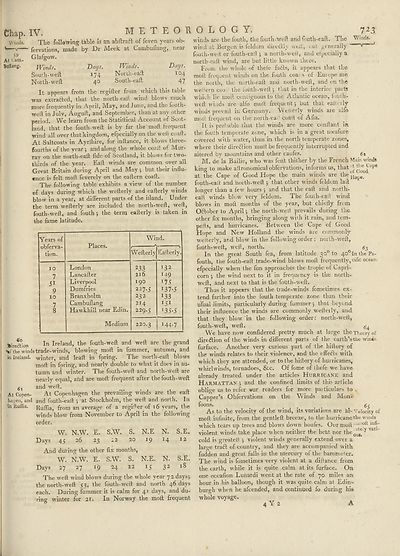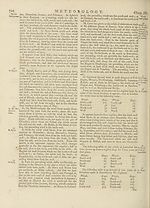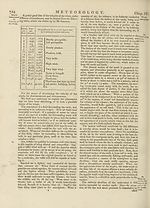Encyclopaedia Britannica, or, a Dictionary of arts, sciences, and miscellaneous literature : enlarged and improved. Illustrated with nearly six hundred engravings > Volume 13, MAT-MIC
(769) Page 723
Download files
Complete book:
Individual page:
Thumbnail gallery: Grid view | List view

Chap. IV.
METEOR
Winds.
59
At Cam-
Bullang.
The following table is an abftraft of feven years ob-
fervations, made by Dr Meek at Cambuflang, near
Glafgow.
Winds. . Bays. Winds. Days.
South-weft 174 Norlh-eaft 104
North-weft 40 South-eaft 47
It appears from the regifter from which this table
was extracted, that the north-eait wind blows much
more frequently in April, May, and June, and the fouth-
weft in July, Auguft, and September, than at any other
period. We learn from the Statillical Account of Scot¬
land, that the fouth-weft is by far the moft frequent
wind all over that kingdom, efpecially on the weft coaft.
At Saltcoats in Ayrihire, for inftance, it blows three-
fourths of the year ; and along the whole coaft of Mur¬
ray on the north-eaft fide of Scotland, it blows for two-
thirds of the year. Eaft winds are common over all
Great Britain during April and May; but their influ-
tnce is felt moft feverely on the eaftern coaft.
The following table exhibits a view of the number
of days during which the wefterly and eafterly winds
blow in a year, at different parts of the ifland. Under
the term wefterly are included the north-weft, weft,
fouth-weft, and fouth ; the term eafterly is taken in
the fame latitude.
Years of
obferva-
tion.
10
7
51
9
10
7
8
Places.
Wefterly Eafterly
London
Lancafter
Liverpool
Dumfries
Branxholm
Cambuflang
Hawkhill near Edin.
Medium
Wind.
233
2x6
190
227-5
232
214
229.5
132
149
175
I37-5
*33
I5I
'35-5
220.3
143.7
»ire<ftion In Ireland, the fouth-weft and weft are the grand
the winds trade-winds, blowing moft in fummer, autumn, and
in Ireland, winter, and leaft in fpring. The north-eaft: blows
moft in fpring, and nearly double to what it does in au¬
tumn and winter. The fouth-weft and north-weft are
nearly equal, and are moft frequent after the fouth-weft
6l and weft.
At Copen- At Copenhagen the prevailing winds are the eaft
hagen, and a„d fouth-eaft ; at Stockholm, the weft and north. In
SnKuffia. Ru{pia? from an average of a regifter of 16 vears, the
winds blow from November to April in the following
order.
W. N.W. E. S.W. S. N.E N. S.E.
Days 45 26 23 12 20 19 14 12
And during the other fix months,
W. N.W. E. S.W. S. N.E. N. S.E.
Days 27 27 19 24 22 15 32 18
The weft wind blows during the whole year 72 days-,
the north-weft 53, the fouth-weft and north 46 days
each. During fummer it is calm for 41 days, and du¬
ring winter for 21. In Norway the moft frequent
6l
O L O G Y.
winds are the fouth, the fouth-we ft and fouth-eaft. The
wind at Bergen is feldora diredtly well, cut generally
fouth-weft or fouth-eaft ; a north-weft, and elpecially a
north-eaft wind, are but little known there.
From the whole of thele fads, it appears that the
moft frequent winds on the fouth coai s of Em ope are
the north, the nurth-eaft and north-weft, and on the
weftern coa the fouth-weft 5 that in the interior parts
which lie moft contiguous to the Atlantic ocean, fouth-
weft winds are alfo moft frequent j but that ealierly
winds prevail in Germany. Vveiietly winds are alfo
moft frequent on the north-ea- coaft of Afia.
It is probable that the winds are more conftant in
the fouth temperate zone, which is in a great meafure
covered with water, than in the north temperate zones,
where their diredion mull be frequently interrupted and
altered by mountains and other caufes.
M. de la Bailie, who was fent thither by the French Main winds
king to make aftronomical obfervations, informs us, that ^ ^^ape
at the Cape of Good Hope the main winds are the^^
fouth-eaft and hoith-weft ; that other winds feldom laft
longer than a few hours -, and that the eaft and north-
eaft winds blow very feldom. The fouth-eaft wind
blows in moft months of the year, but chiefly from
Odober to April -, the north-weft prevails during the
other fix months, bringing along with it rain, and tem-
pefts, and hurricanes. Between the Cape of Good
Hope and New Holland the winds are commonly
wetterly, and blow in the following order : north-weft,
fouth-weft, weft, north. 63
In the great South fea, from latitude 30° to 40° In the Pa-
fouth, the fouth-eaft trade-wind blows moft frequently,ede ocean,
efpecially when the fun approaches the tropic of Capri¬
corn -, the wind next to it in frequency is the north-
weft, and next to that is the fotlth-weft.
Thus it appears that the trade-winds fometimes ex¬
tend farther into the fouth temperate zone than their
ufual limits, particularly during fummer-, that beyond
their influence the winds are commonly wetterly, and
that they blow in the following order: north-weft,
fouth-weft, weft. ^
We have now confidered pretty much at large the Theory of
dire dion of the winds in different parts of the earth’s the winds,
furface. Another very curious part of the hiftory of
the winds relates to their violence, and the effeds with
which they are attended, or to the hiftory of hurricanes,
whirlwinds, tornadoes, &c. Of fome of thefe we have
already treated under the articles Hurricane and
Harmattan -, and the confined limits of this article
oblige us to refer eur readers for more particulars to
Capper’s Obfervations on the Winds and Mon-
foons. _ 53
As to the velocity of the wind, its variations are al- Velocity of
moft infinite, from the gentleft breeze, to the hurricane the winds
which tears up trees and blows down houfes. Our moll '‘i; olt in*!-
violent winds take place when neither the heat nor the^® y
cold is greatelt 5 violent winds generally extend over a
large trad of country, and they are accompanied with
hidden and great falls in the mercury of the barometer.
The wind is fometimes very violent at a diftance from
the earth, while it is quite calm at its furface. On
one occafion Lunardi went at the rate of 70 miles an
hour in his balloon, though it was quite calm at Edin¬
burgh when he afeended, and continued fo during his
whole voyage.
4 Y 2 A.
METEOR
Winds.
59
At Cam-
Bullang.
The following table is an abftraft of feven years ob-
fervations, made by Dr Meek at Cambuflang, near
Glafgow.
Winds. . Bays. Winds. Days.
South-weft 174 Norlh-eaft 104
North-weft 40 South-eaft 47
It appears from the regifter from which this table
was extracted, that the north-eait wind blows much
more frequently in April, May, and June, and the fouth-
weft in July, Auguft, and September, than at any other
period. We learn from the Statillical Account of Scot¬
land, that the fouth-weft is by far the moft frequent
wind all over that kingdom, efpecially on the weft coaft.
At Saltcoats in Ayrihire, for inftance, it blows three-
fourths of the year ; and along the whole coaft of Mur¬
ray on the north-eaft fide of Scotland, it blows for two-
thirds of the year. Eaft winds are common over all
Great Britain during April and May; but their influ-
tnce is felt moft feverely on the eaftern coaft.
The following table exhibits a view of the number
of days during which the wefterly and eafterly winds
blow in a year, at different parts of the ifland. Under
the term wefterly are included the north-weft, weft,
fouth-weft, and fouth ; the term eafterly is taken in
the fame latitude.
Years of
obferva-
tion.
10
7
51
9
10
7
8
Places.
Wefterly Eafterly
London
Lancafter
Liverpool
Dumfries
Branxholm
Cambuflang
Hawkhill near Edin.
Medium
Wind.
233
2x6
190
227-5
232
214
229.5
132
149
175
I37-5
*33
I5I
'35-5
220.3
143.7
»ire<ftion In Ireland, the fouth-weft and weft are the grand
the winds trade-winds, blowing moft in fummer, autumn, and
in Ireland, winter, and leaft in fpring. The north-eaft: blows
moft in fpring, and nearly double to what it does in au¬
tumn and winter. The fouth-weft and north-weft are
nearly equal, and are moft frequent after the fouth-weft
6l and weft.
At Copen- At Copenhagen the prevailing winds are the eaft
hagen, and a„d fouth-eaft ; at Stockholm, the weft and north. In
SnKuffia. Ru{pia? from an average of a regifter of 16 vears, the
winds blow from November to April in the following
order.
W. N.W. E. S.W. S. N.E N. S.E.
Days 45 26 23 12 20 19 14 12
And during the other fix months,
W. N.W. E. S.W. S. N.E. N. S.E.
Days 27 27 19 24 22 15 32 18
The weft wind blows during the whole year 72 days-,
the north-weft 53, the fouth-weft and north 46 days
each. During fummer it is calm for 41 days, and du¬
ring winter for 21. In Norway the moft frequent
6l
O L O G Y.
winds are the fouth, the fouth-we ft and fouth-eaft. The
wind at Bergen is feldora diredtly well, cut generally
fouth-weft or fouth-eaft ; a north-weft, and elpecially a
north-eaft wind, are but little known there.
From the whole of thele fads, it appears that the
moft frequent winds on the fouth coai s of Em ope are
the north, the nurth-eaft and north-weft, and on the
weftern coa the fouth-weft 5 that in the interior parts
which lie moft contiguous to the Atlantic ocean, fouth-
weft winds are alfo moft frequent j but that ealierly
winds prevail in Germany. Vveiietly winds are alfo
moft frequent on the north-ea- coaft of Afia.
It is probable that the winds are more conftant in
the fouth temperate zone, which is in a great meafure
covered with water, than in the north temperate zones,
where their diredion mull be frequently interrupted and
altered by mountains and other caufes.
M. de la Bailie, who was fent thither by the French Main winds
king to make aftronomical obfervations, informs us, that ^ ^^ape
at the Cape of Good Hope the main winds are the^^
fouth-eaft and hoith-weft ; that other winds feldom laft
longer than a few hours -, and that the eaft and north-
eaft winds blow very feldom. The fouth-eaft wind
blows in moft months of the year, but chiefly from
Odober to April -, the north-weft prevails during the
other fix months, bringing along with it rain, and tem-
pefts, and hurricanes. Between the Cape of Good
Hope and New Holland the winds are commonly
wetterly, and blow in the following order : north-weft,
fouth-weft, weft, north. 63
In the great South fea, from latitude 30° to 40° In the Pa-
fouth, the fouth-eaft trade-wind blows moft frequently,ede ocean,
efpecially when the fun approaches the tropic of Capri¬
corn -, the wind next to it in frequency is the north-
weft, and next to that is the fotlth-weft.
Thus it appears that the trade-winds fometimes ex¬
tend farther into the fouth temperate zone than their
ufual limits, particularly during fummer-, that beyond
their influence the winds are commonly wetterly, and
that they blow in the following order: north-weft,
fouth-weft, weft. ^
We have now confidered pretty much at large the Theory of
dire dion of the winds in different parts of the earth’s the winds,
furface. Another very curious part of the hiftory of
the winds relates to their violence, and the effeds with
which they are attended, or to the hiftory of hurricanes,
whirlwinds, tornadoes, &c. Of fome of thefe we have
already treated under the articles Hurricane and
Harmattan -, and the confined limits of this article
oblige us to refer eur readers for more particulars to
Capper’s Obfervations on the Winds and Mon-
foons. _ 53
As to the velocity of the wind, its variations are al- Velocity of
moft infinite, from the gentleft breeze, to the hurricane the winds
which tears up trees and blows down houfes. Our moll '‘i; olt in*!-
violent winds take place when neither the heat nor the^® y
cold is greatelt 5 violent winds generally extend over a
large trad of country, and they are accompanied with
hidden and great falls in the mercury of the barometer.
The wind is fometimes very violent at a diftance from
the earth, while it is quite calm at its furface. On
one occafion Lunardi went at the rate of 70 miles an
hour in his balloon, though it was quite calm at Edin¬
burgh when he afeended, and continued fo during his
whole voyage.
4 Y 2 A.
Set display mode to:
![]() Universal Viewer |
Universal Viewer | ![]() Mirador |
Large image | Transcription
Mirador |
Large image | Transcription
Images and transcriptions on this page, including medium image downloads, may be used under the Creative Commons Attribution 4.0 International Licence unless otherwise stated. ![]()
| Permanent URL | https://digital.nls.uk/192694047 |
|---|
| Attribution and copyright: |
|
|---|
| Description | Ten editions of 'Encyclopaedia Britannica', issued from 1768-1903, in 231 volumes. Originally issued in 100 weekly parts (3 volumes) between 1768 and 1771 by publishers: Colin Macfarquhar and Andrew Bell (Edinburgh); editor: William Smellie: engraver: Andrew Bell. Expanded editions in the 19th century featured more volumes and contributions from leading experts in their fields. Managed and published in Edinburgh up to the 9th edition (25 volumes, from 1875-1889); the 10th edition (1902-1903) re-issued the 9th edition, with 11 supplementary volumes. |
|---|---|
| Additional NLS resources: |
|

